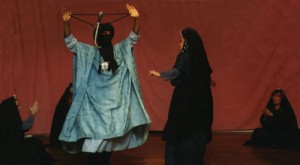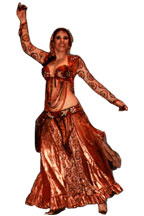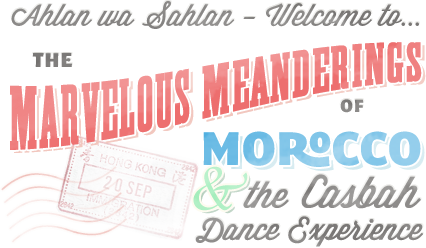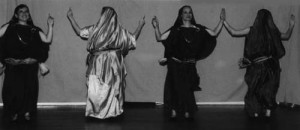By Morocco (Carolina Varga Dinicu)
To be considered folk or ethnic does not mean being swathed in black from head to foot or being in lines and circle formations only. Nor does fitting into any of the above make a performance or performer valid, talented or in good taste.
A good point is raised when dancers are questioned about doing “Arabic” dances to Israeli music, bare midriffs, et al. But to refer in any way to Mideastern Oriental dance as “hootchy-kootchy” is, of course, insulting and ignorant.
Likewise, any person professing to be knowledgeable about this dance form who uses the misnomer exploited by Sol Bloom in 1893: “belly” dance, is perpetuating racism, colonialism, and mid-Victorian Orientalist misconceptions. The translation of “Raks Sharki” (what it is called in Arabic) is Oriental Dance, but since that term in America has become narrowed by common usage to designate just the Far East,Mideastern Oriental can be used to more clearly designate a geographic area.
There is no term in Arabic ever used for the dance that would translate as “belly” dance, nor is there any other dance form anywhere in the world that is named for a body part, especially since only two of the myriad movements involved are done with the aforementioned muscle, whose proper name is “abdominal” to begin with.
Mr Bloom used the vulgarized translation of the French description of some of the movements of the Ouled Nail: “Danse du Ventre”, knowing full well it would titillate the hypocritical mid-Victorian mentality that considered the words “arm” and “leg” socially unacceptable. Let’s face it, Solly was in business to make money.
Pictures exist of all the North African, Mediterranean, Near and Mideastern performers at the Colombian Trade Fair & Exposition of 1893 — all of whom were fully clad: more so even than the Hungarian and English performers at the Moorish Palace thereafter.
Captions under thoses photos indicate that although “the movements were not graceful dance as we know it, they are not vulgar”. Sol Bloom couldn’t make money on that, so he “banned” women from his Egyptian theater at the “Streets of Cairo” exhibit. They had to sit in his coffee house, paying high rates for pastries (and smoking hookahs — water-pipes), while the men — all the more attracted to something so “forbidden” — paid premium rates to see it. The theater was packed and Sol made a mint: enough to later finance his Congressional campaign for the 65th Election District in New York City.
His clever publicity campaign gave a legitimate ethnic dance form an undeserved and still perpetuated salacious reputation.Then again, in that day and age, any dancer — and especially a Third World female — was considered beyond the pale of “civilized” Christian morality.”

The fabulous and legendary Tahia Carioca was called “Carioca” because she used a step from that then – popular Latin social dance in her Oriental routine. Samia Gamal was the first to enter with a veil in her hands, flowing behind her, to be discarded shortly after the entrance. “Veilwork”, per se, is an American invention. So what!!
Since they are Egyptians, and they were in Egypt, did that then make it authentic, innovative, de rigeur, or what? The National Folklore Troupe of Egypt (Firqua Kawmiyya), the Reda Troupe, and all their various offshoots are definitely “Moscow-on-the-Nile”, since under Nasser, not only were many Russian ballet teachers imported, but some of the best and most talented young Egyptians were sent to study in Russia. The choreography of even the folklore was supervised and influenced by Soviet pseudo – “Ethnic” styling and all the young dancers were trained by Soviet dance teachers.
A prime example is what happened to the “Haggala”. When done in Libya (where it is from), Mersa Matruh or anywhere else where it was/is indigenous, one woman dances, her face and head covered, in front of a group of men, who stand in a line behind her, singing and clapping. The step is a vigorous, rapid up two side, side hip articulation. The Kawmiyya and Reda troupes have made it into quite a production, wherein several women dance (Kawmiyya version – Reda uses one woman), then the men dance; what they do is purely the choreographer’s imagination: Ukrainian Hopak for the Kawmiyya and athletic acrobatics for the Reda troupe.
Now picture this: young American dance freak (or not so young) goes to Egypt, sees one of the above or sees them in the U.S. on videotape. I mean, I’m in Egypt, or they’re real Egyptians, therefore what I’m seeing is real, right? Wrong! So how is a poor dancer to know? Even Egyptians who haven’t been near Matruh (who couldn’t care less) accept it as real. You have to know what you are watching to know what you are seeing!!!
Syrians, Palestinians, Lebanese, Jordanians can pass judgement on various regional Debkes. Moroccans, Algerians, Iranians, Tunisians and Egyptians can’t. Tunisian folklore is completely different from Moroccan, both from Algerian and all from Egyptian, and so on. Unless s/he had been in Morocco and had spent time in Goulimine or TanTan, no Palestinian could tell you if a Guedra or T’bal were done “properly”, whereas he or she could certainly tell you if it were done gracefully, respectfully, if the choreography were varied and interesting enough to hold attention, as could any cultured member of any audience.
A Palestinian probably can tell you if the music, costuming, and steps of any dance you choose to call Palestinian are correct — if his family or village did that particular variation or wore that particular pattern of embroidery. Get the idea?
Being born in the Middle East, North Africa, wherever, doesn’t mean a damned thing other than that that person might have been exposed to the music and/or certain dances, might have had a chance to do them in the home or at haflas, moulids, weddings, etc.
Being of Mideastern descent? Being married to a Mideasterner? Come on! I’m a full blooded Gypsy. My mother happened to be in Transylvania the day I was born. (Honest.) I don’t live in an empty store, sell horses, tell fortunes, or bite people on the neck at night (OK: maybe sometimes I might bite …). My granduncle was the phenomenal violinist Grigorash Dinicu. Can I play the violin? Hell , no!

Oriental dance is just one of the many different dances indigenous to those areas of the world. Because nowadays it is usually a solo performance by a female and the general styling of modern costuming is bare – midriffed and glamorous, it is the most well-known and ofttimes “notorious” of the dances of those regions. Also because of the misnomer “belly” dance and resulting misconceptions, truly talented, studied dancers have had problems in being taken seriously as artists.
They have often run into far fewer problems and misinterpretations if and when they dress in drab colors, dance in twos, threes or more and say: “It’s NOT ‘belly’ dance, it’s ‘ethnic’.”Ergo, the very interesting and often beautiful fantasies of “tribal” stylings that have never seen a real tribe. I see nothing wrong with that if it is presented as such, i.e. this is our conception of. . ., and providing it is not racist or condescending. I have seen some fantastic “Tribal” – it’s wonderful theater.
A few examples of dancers imparting serious misinformation that I have personally seen are:
- “When women of the . . . tribe meet each other on the street, they greet each other by shaking their coin bras,” – or –
- “A woman is dancing her prayer to Allah in the mosque so that her lover will be victorious in battle” (this in Oriental costume!) – or –
- An entire group turning their backs to the audience and flipping up the skirts of their “ethnic” dresses to expose their backsides, a la can-can. EGAD! Not only real ethnics but anybody who’s been there is ready to scream -or-
- Wearing Turkish hat covers – tepeleks – as bra cups, or coming out in boys’ circumcision caps….
Coin bras are Hollywood. In the first place, it was good old Howard Hughes who invented the uplift bra (for Jane Russell in the film “The Outlaw”] — and caused quite a scandal, my dear! Nowhere in that climate is anyone masochistic enough to run around in metal coins over a bare midriff. No part of the body is exposed except the hands and the face.
Dance in a Mosque? In Oriental costume? Not only wouldn’t she get her prayers answered, she’d probably be stoned to death. The last two don’t need additional explanation.
For centuries, Oriental dance was done by women for women in the privacy of their quarters in whatever they wore around the house / harem at the time; and you bet your bippy it varied greatly from area to area, era to era, economic class and temperature. When, for whatever reason, it was done as a spectacle by paid performers, they were sure to dress up in the best available to them geographically, technically, and economically.
Romanian and Balkan folk dancers didn’t perform at festivals and weddings in their everyday ratty workclothes. They hauled out the painstakingly embroidered and appliqued goodies. That was/is their glitz. Their state ensembles aren’t above using sequins for performance – when and if they can get them.
The various Berber tribes get into full regalia and special (!) makeup for their festivals — they don’t run around the Atlas mountains herding sheep in those outfits every day. I know. I’ve been there.
As far as pasties being part of an Oriental costume is concerned: there are two album covers, one with Nejla Atesh: “Port Said” (Mohamed el Bakkar), the other Boubouka: “Dances of Port Said” (those photos have been used on other album covers too.) Those pictures were taken when the dancers in question were working at the Latin Quarter night club in New York in the mid – fifties, where it was a club requirement that all female performers wear pasties, no matter what dance form.
In the mid-sixties I was offered a headlining spot there, with the same proviso. I refused. That was a unique requirement of various specific clubs from time to time and at NO time a usual part of the costume “over there”.
I think we should also consider that for many centuries Oriental dance has been done in the home by women for women for their own enjoyment, and it is only the public display of the same that became associated with prostitution, in a society where any public appearance of any female – most especially on stage, in front of strange men, was and still is met with hostility, suspicion, and disapproval.
Of course, prostitutes did it, just as in the Spanish brothels you can find a corrupted version of Flamenco, or jazz in New Orleans whorehouses. Sleaze is sleaze and an artist is an artist, the main criteria should be taste, ability, class and talent.
A fine Oriental dance belongs in any performance of Near and Mideastern, North African, Central Asian, Mediterranean or any other generalized folk dances or just beautiful dances in general, but it certainly is not the only dance indigenous to those areas. We are in a world where just about any information is available for study and assimilation if effort is put forth. We are in a country where, theoretically, there is nothing wrong in a woman being a performer if that performance is tasteful, graceful.
Misinterpretations of Islam have been very responsible for the repression of every form of dance and especially any dancing in public by women. I could turn this into a doctoral thesis by giving only a portion of the examples, but it will suffice to say that at the Bahariyya Oasis in Egypt, dance parts that were originally done by women are now done by young boys dressed as women, and several times in the history of Turkey, Persia and Central Asia, dancing boys dressed as girls had to substitute for the outlawed dancing girls.
They don’t have a monopoly on sexism: in Shakespeare’s time women were banned from the stage. Juliet was first played by a boy. We can’t call it Arabic dance either because many dance forms still exist in those areas today that were done before Arabification and conversion to Islam, and they continue best and strongest where the Arabs penetrated least.
Just as hypocritical, filthy – minded, body – fearing missionaries misunderstood the strictly religious Hulas of Hawaii and outlawed them so effectively that the barest minimum remain, the puritanical “Socialist” government of Algeria outlawed not only prostitution by the Ouled Nail, but their beautiful dancing too. Nasser’s early government tried to outlaw public dancing by women but reinstated it by popular and tourist dollar demand. Sultan Mohamed Ali exiled all dancing girls (and boys) to Esna, Edfu and Sumbat in an attempt to curry favor with the British colonials; I could go on ad infinitum.
I think it was more than high time that the question was raised and answered, and while I agreed basically with the complaints put forth by many, I felt that there were important points that weren’t sufficiently clarified or explained. There is definitely room for all kinds of creativity and artistry, but things should be called by their rightful names.
Everyone seems to’ve forgotten that because of an interest in Oriental dance, however it may have occured, thousands of people — probably hundreds of thousands, maybe even millions, now that I think of it — have been made aware of a music and dance tradition from another area of the world. If the performance was a good one, if the lessons made the student happy, they probably probed deeper into the cultures to which it belongs, thus achieving a far better or more positive understanding than they could have gotten from news events or in the course of their ordinary lives.
That is definitely for the good of all concerned, don’t you think?

